As was noted in the previous post, this was a short week due to the holiday of Isra wa al-Miraj. Regardless, during our three days of class (Monday, Tuesday, and Wednesday) we continued to follow the structured learning schedule established during our first week in Nizwa.
I can notice my ability in Arabic taking small jumps forward. Its interesting that this improvement occurs in such “quantum increments,” and usually a day of noticeable progress is followed by a day of apparent backsliding, as if my brain needs a day to reboot before taking in any more Arabic. Indeed, on a few days this week I had some weird moments after school, when my roommates were talking to each other in English. As they were speaking, I had trouble processing the English words because my ear was expecting to hear Arabic sounds and rhythms. “Great,” I thought, “now I can’t understand any language.” Luckily my comprehension snapped back into place after a few seconds of confusion.
After this short week was over, the girls in the group went to a wedding to which they all had been invited in our first week at the university. The months of June and July are wedding season in Oman, and the brother of Aisha, one of our group’s peer facilitators (or talibat musa’ida), was marrying a local woman; in fact, it was in preparation for this wedding that the girls had their hands and forearms decorated with henna during our first week of classes–you might have seen the pictures in the album which I linked to in my previous post (these can also be viewed by clicking on the “Week One” photos link to the right.
Men are not allowed to attend the wedding ceremony itself, so the girls went and reported back to us. They told us that the only men in the room were the bride’s father, her brothers, and at the very end, the groom (Aisha’s brother). They told us that, due to this lack of lusty male gazing, the wedding was an occasion in which Omani women do not feel constrained to wear an abaya, which is the black, robe-like outer garment that all the women here wear when they are out in public; instead, women at weddings wear very colorful, ornamental dresses. Furthermore, according to the girls, there was lots of music and dancing, which is something I have not seen nor expect to see in Nizwa. Of course there was no alcohol but plenty of food, according to the girls.
While the ladies were at the wedding that night, the shabaab and I went to a Turkish coffee shop and grill (a “mushawi”) and had dinner and watched a repeat of the Sweden-France Euro Cup match, before meeting back up with the girls to learn about the wedding.
The next morning,– a Thursday– Matt, Ian, James, Carter, and I decided to explore some of the mountainous terrain behind our neighborhood. We left our apartment and began to explore the wadi, or valley; this wadi is actually part of a network of dry river beds that drain the mountains around Nizwa when it rains. We followed the wadi system, for about 2 miles, up to the base of what we considered to be the highest peak in the vicinity.

Behind our apartment, the dry wadi that leads to the base of the mountain we are about to climb. We walked through this wadi for about two miles.
From here we began to climb; after a roughly 30 minute ascent, we were standing at the summit of this small mountain, which afforded us some outstanding views of the mountains to the north, south and west of us, and the city of Nizwa and more mountains to the east. Incidentally, Nizwa is derived from an Arabic root meaning both “from the mountain” and “isolated.”
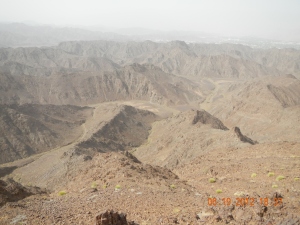
Getting close to the top of the mountain, looking down into the valley below us. The climb itself only took about 25 minutes after we got to the base of the mountain.
After this excursion we were all pretty exhausted and we went back to the authentic Omani restaurant to dine, and after that we ventured to “Nizwa Nights,” the local night spot to watch the Euro Cup match Portugal and France and drink coffee. I was feeling pretty tired at this point and I knew that we had a big day ahead of us because Larry, Judy, and Faisal, the organizers of our stay here, had planned an excursion for us on Friday.
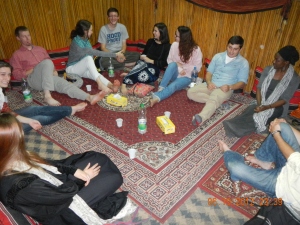
Before ordering at the Omani restaurant. Here everyone has just gotten settled in the dining room. Every place I’ve eaten in Oman uses kleenex as napkins; bottled water usually appears soon after you sit at the table or on the floor.
We all woke early the next day to go to the highest point in Nizwa, al-Jabal al-Akhdar, or the Green Mountain, which reaches just over 10,000 feet at its highest point. About twenty minutes east of Nizwa, we stopped in Birkat al-Mouz, or “Bounty of Bananas,” on the way to meet the group from Muscat which had traveled with us last week to Bahla and al-Hamra. I suppose that Birkat could be roughly analogous to my birthplace, Hickory, NC, as both are crossroads towns that serve as gateways to the mountains–although Hickory is much bigger and more populous. In Birkat, there was a falaj, an old masjid, and some watch towers, and the pictures here provide a good idea of the local landscape of small towns in this north eastern part of Oman.
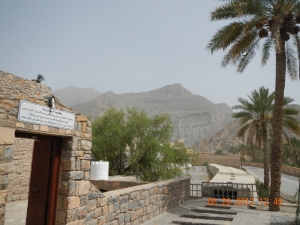
The old masjid in Birkat al-Mauz, with the Jabal al-Akhdar mountains in the background and the falaj of the city running past the building’s front door.

In Birkat al-Mauz, some of the group walking back along the falaj in order to board the bus to Green Mountain, or al-Jabal al-Akhdar
From Birkat we proceeded up the mountain, stopping several times to take in the views; the mountain range, the Hajar al-Gharb, is apparently a very famous tourist spot in the Middle East; in fact Princess Di came here with her lover Dodi Fayed (or Prince Charles–I heard both narratives but to me the former seems more likely), and there is a spot near our second stop now known as Diana’s Point.
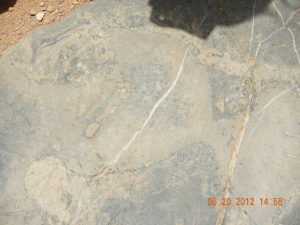
On the way up the mountain, we stopped at several overlooks. At one point, we saw this fossilized fish, at over 9000 feet altitude. Al-Jabal al-Akhdar and the surrounding mountain range we were once on the ocean floor.
Finally we reached the mountain community of al-Ayn, where we stopped for another Yemeni-style lunch. After lunch we went to the old village of Al-Ayn which is remarkable and regionally famous for its gardens and agriculture, especially for its roses, pomegranates, and date palms–which are all over Oman anywhere there is water. As is so common here, there was an intricate falaj system running through al-Ayn which was really fascinating to me.
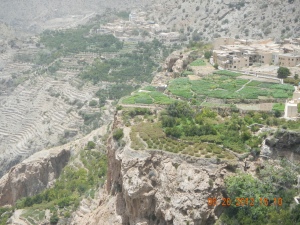
Gardens high above the valley on Jabal al-Akhdar; the fertile and fallow terraces are really visible in the left of the photo.

View from the streets of al-Ayn. The buildings join each other over the street, providing shelter for the walkways.
After a very nice tour of al-Ayn, we took a short drive to a site where we were able to look out across a wadi in which there were three villages scattered below us, and here we received a short history lesson about the region and its role in the Jabal al-Akhdar war in the late 1950s. This war pitted the Imamate against the Sultanate. The Imamate was a polity led by the Ibadhi imam of Oman and galvanized by the perception that the Sultan Said bin Taimur (the father of the current Sultan, Qaboos) was giving all the valuable land and resources of Oman to the British, and only after British intervention on behalf of the Sultan was the war decided in favor of the government in Muscat.
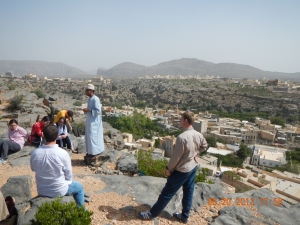
Listening to a lecture on the history of al-Jabal al-Akhdar.
Following this poignant historical narrative, related to us by our native Omani guide, we went to a village that had been bombed by the Royal Air Force during the Jabal al-Akdhar war. Exploring these ruins, many of still containing relics and trappings of daily life, I was constantly struck with a strange mix of nostalgia and guilt, stemming from the idea that someone once had a life here, interrupted by war, and that we were desecrating their memory.

A close up of the village across the wadi from the village that we explored. Both villages were bombed the RAF during the Jabal al-Akhdar war.
During this adventure, some of our group (Carter, Matt, Natasha, Jessica) ascended the mountain above the village. After everyone came down we made our way back by following the falaj which once linked the bombed out villages with the wadi beneath them, and we returned to the place where our buses were parked. There we had some Omani coffee and dates, and some of the group purchased the locally famous rosewater produced in the area. There were also holistic medicines and curatives, made from local flora, for sale here.
As the sun began to sink in the sky, we began loading in to the buses and to leave this beautiful mountain and return to Nizwa. We got back to Nizwa at about 7:30 p.m., ate dinner at One World Restaurant–a spot that has quickly become one of our favorites–and got back to the apartment around 10:00 to hit the hay and get ready for our third week of classes at the “Jami’at Nizwa” (Univeristy of Nizwa).
For more visuals of what I experienced this weekend, all the photos related to this post can be viewed here. I apologize in advance for the overabundance of mountain, rock, and palm tree photos–its pretty much all I have to work with!
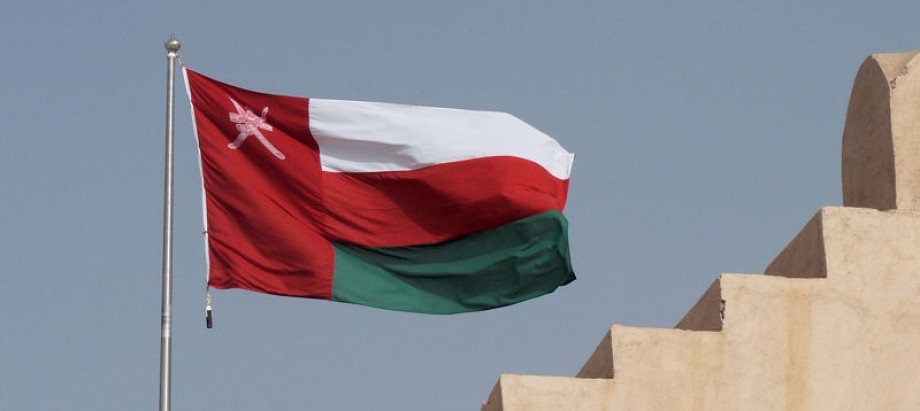
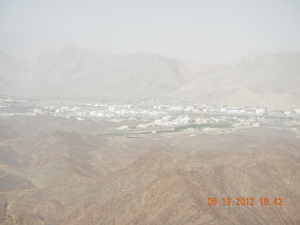

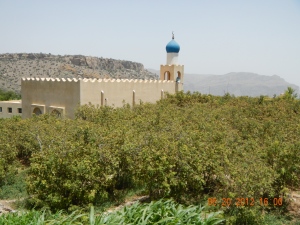


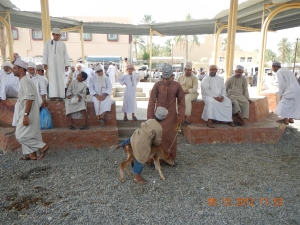
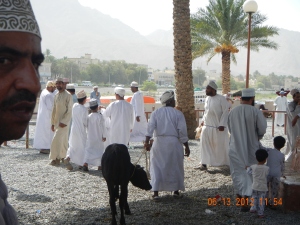

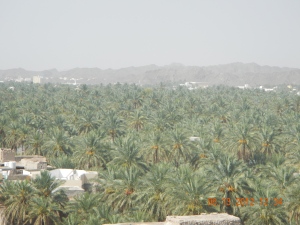

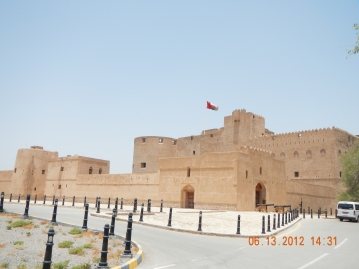
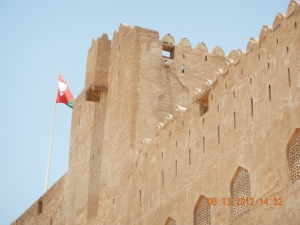
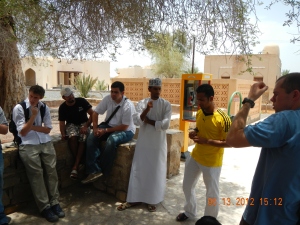




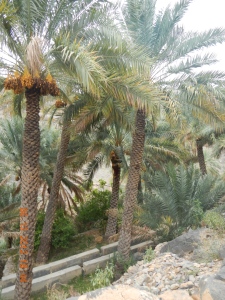
 Nizwa Time
Nizwa Time